Yucheng Li
SecurityLingua: Efficient Defense of LLM Jailbreak Attacks via Security-Aware Prompt Compression
Jun 15, 2025Abstract:Large language models (LLMs) have achieved widespread adoption across numerous applications. However, many LLMs are vulnerable to malicious attacks even after safety alignment. These attacks typically bypass LLMs' safety guardrails by wrapping the original malicious instructions inside adversarial jailbreaks prompts. Previous research has proposed methods such as adversarial training and prompt rephrasing to mitigate these safety vulnerabilities, but these methods often reduce the utility of LLMs or lead to significant computational overhead and online latency. In this paper, we propose SecurityLingua, an effective and efficient approach to defend LLMs against jailbreak attacks via security-oriented prompt compression. Specifically, we train a prompt compressor designed to discern the "true intention" of the input prompt, with a particular focus on detecting the malicious intentions of adversarial prompts. Then, in addition to the original prompt, the intention is passed via the system prompt to the target LLM to help it identify the true intention of the request. SecurityLingua ensures a consistent user experience by leaving the original input prompt intact while revealing the user's potentially malicious intention and stimulating the built-in safety guardrails of the LLM. Moreover, thanks to prompt compression, SecurityLingua incurs only a negligible overhead and extra token cost compared to all existing defense methods, making it an especially practical solution for LLM defense. Experimental results demonstrate that SecurityLingua can effectively defend against malicious attacks and maintain utility of the LLM with negligible compute and latency overhead. Our code is available at https://aka.ms/SecurityLingua.
R-KV: Redundancy-aware KV Cache Compression for Training-Free Reasoning Models Acceleration
May 30, 2025Abstract:Reasoning models have demonstrated impressive performance in self-reflection and chain-of-thought reasoning. However, they often produce excessively long outputs, leading to prohibitively large key-value (KV) caches during inference. While chain-of-thought inference significantly improves performance on complex reasoning tasks, it can also lead to reasoning failures when deployed with existing KV cache compression approaches. To address this, we propose Redundancy-aware KV Cache Compression for Reasoning models (R-KV), a novel method specifically targeting redundant tokens in reasoning models. Our method preserves nearly 100% of the full KV cache performance using only 10% of the KV cache, substantially outperforming existing KV cache baselines, which reach only 60% of the performance. Remarkably, R-KV even achieves 105% of full KV cache performance with 16% of the KV cache. This KV-cache reduction also leads to a 90% memory saving and a 6.6X throughput over standard chain-of-thought reasoning inference. Experimental results show that R-KV consistently outperforms existing KV cache compression baselines across two mathematical reasoning datasets.
Compressive Fourier-Domain Intensity Coupling (C-FOCUS) enables near-millimeter deep imaging in the intact mouse brain in vivo
May 27, 2025Abstract:Two-photon microscopy is a powerful tool for in vivo imaging, but its imaging depth is typically limited to a few hundred microns due to tissue scattering, even with existing scattering correction techniques. Moreover, most active scattering correction methods are restricted to small regions by the optical memory effect. Here, we introduce compressive Fourier-domain intensity coupling for scattering correction (C-FOCUS), an active scattering correction approach that integrates Fourier-domain intensity modulation with compressive sensing for two-photon microscopy. Using C-FOCUS, we demonstrate high-resolution imaging of YFP-labeled neurons and FITC-labeled blood vessels at depths exceeding 900 um in the intact mouse brain in vivo. Furthermore, we achieve transcranial imaging of YFP-labeled dendritic structures through the intact adult mouse skull. C-FOCUS enables high-contrast fluorescence imaging at depths previously inaccessible using two-photon microscopy with 1035 nm excitation, enhancing fluorescence intensity by over 20-fold compared to uncorrected imaging. C-FOCUS provides a broadly applicable strategy for rapid, deep-tissue optical imaging in vivo.
MMInference: Accelerating Pre-filling for Long-Context VLMs via Modality-Aware Permutation Sparse Attention
Apr 22, 2025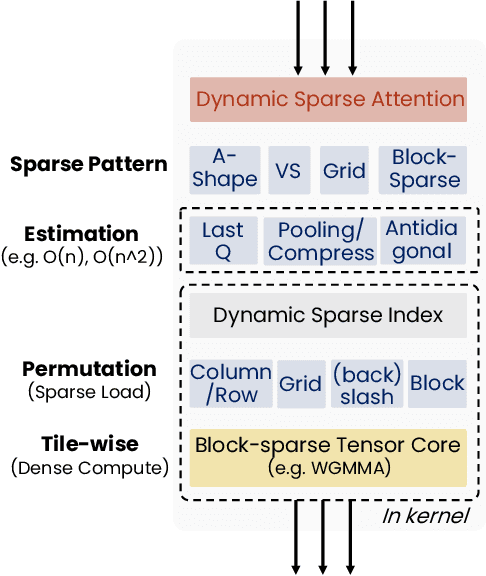
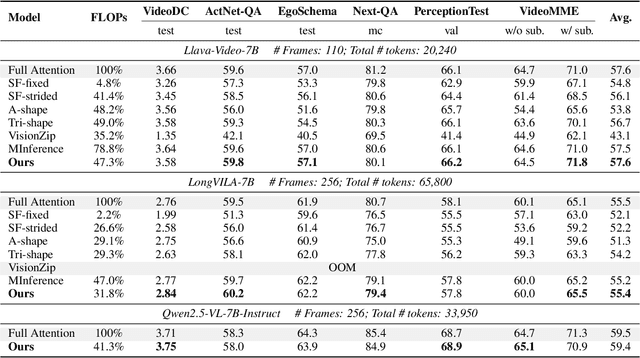


Abstract:The integration of long-context capabilities with visual understanding unlocks unprecedented potential for Vision Language Models (VLMs). However, the quadratic attention complexity during the pre-filling phase remains a significant obstacle to real-world deployment. To overcome this limitation, we introduce MMInference (Multimodality Million tokens Inference), a dynamic sparse attention method that accelerates the prefilling stage for long-context multi-modal inputs. First, our analysis reveals that the temporal and spatial locality of video input leads to a unique sparse pattern, the Grid pattern. Simultaneously, VLMs exhibit markedly different sparse distributions across different modalities. We introduce a permutation-based method to leverage the unique Grid pattern and handle modality boundary issues. By offline search the optimal sparse patterns for each head, MMInference constructs the sparse distribution dynamically based on the input. We also provide optimized GPU kernels for efficient sparse computations. Notably, MMInference integrates seamlessly into existing VLM pipelines without any model modifications or fine-tuning. Experiments on multi-modal benchmarks-including Video QA, Captioning, VisionNIAH, and Mixed-Modality NIAH-with state-of-the-art long-context VLMs (LongVila, LlavaVideo, VideoChat-Flash, Qwen2.5-VL) show that MMInference accelerates the pre-filling stage by up to 8.3x at 1M tokens while maintaining accuracy. Our code is available at https://aka.ms/MMInference.
LongEval: A Comprehensive Analysis of Long-Text Generation Through a Plan-based Paradigm
Feb 26, 2025Abstract:Large Language Models (LLMs) have achieved remarkable success in various natural language processing tasks, yet their ability to generate long-form content remains poorly understood and evaluated. Our analysis reveals that current LLMs struggle with length requirements and information density in long-text generation, with performance deteriorating as text length increases. To quantitively locate such a performance degradation and provide further insights on model development, we present LongEval, a benchmark that evaluates long-text generation through both direct and plan-based generation paradigms, inspired by cognitive and linguistic writing models. The comprehensive experiments in this work reveal interesting findings such as that while model size correlates with generation ability, the small-scale model (e.g., LongWriter), well-trained on long texts, has comparable performance. All code and datasets are released in https://github.com/Wusiwei0410/LongEval.
SCBench: A KV Cache-Centric Analysis of Long-Context Methods
Dec 13, 2024



Abstract:Long-context LLMs have enabled numerous downstream applications but also introduced significant challenges related to computational and memory efficiency. To address these challenges, optimizations for long-context inference have been developed, centered around the KV cache. However, existing benchmarks often evaluate in single-request, neglecting the full lifecycle of the KV cache in real-world use. This oversight is particularly critical, as KV cache reuse has become widely adopted in LLMs inference frameworks, such as vLLM and SGLang, as well as by LLM providers, including OpenAI, Microsoft, Google, and Anthropic. To address this gap, we introduce SCBench(SharedContextBench), a comprehensive benchmark for evaluating long-context methods from a KV cachecentric perspective: 1) KV cache generation, 2) KV cache compression, 3) KV cache retrieval, 4) KV cache loading. Specifically, SCBench uses test examples with shared context, ranging 12 tasks with two shared context modes, covering four categories of long-context capabilities: string retrieval, semantic retrieval, global information, and multi-task. With it, we provide an extensive KV cache-centric analysis of eight categories long-context solutions, including Gated Linear RNNs, Mamba-Attention hybrids, and efficient methods such as sparse attention, KV cache dropping, quantization, retrieval, loading, and prompt compression. The evaluation is conducted on 8 long-context LLMs. Our findings show that sub-O(n) memory methods suffer in multi-turn scenarios, while sparse encoding with O(n) memory and sub-O(n^2) pre-filling computation perform robustly. Dynamic sparsity yields more expressive KV caches than static patterns, and layer-level sparsity in hybrid architectures reduces memory usage with strong performance. Additionally, we identify attention distribution shift issues in long-generation scenarios. https://aka.ms/SCBench.
On the Rigour of Scientific Writing: Criteria, Analysis, and Insights
Oct 07, 2024



Abstract:Rigour is crucial for scientific research as it ensures the reproducibility and validity of results and findings. Despite its importance, little work exists on modelling rigour computationally, and there is a lack of analysis on whether these criteria can effectively signal or measure the rigour of scientific papers in practice. In this paper, we introduce a bottom-up, data-driven framework to automatically identify and define rigour criteria and assess their relevance in scientific writing. Our framework includes rigour keyword extraction, detailed rigour definition generation, and salient criteria identification. Furthermore, our framework is domain-agnostic and can be tailored to the evaluation of scientific rigour for different areas, accommodating the distinct salient criteria across fields. We conducted comprehensive experiments based on datasets collected from two high impact venues for Machine Learning and NLP (i.e., ICLR and ACL) to demonstrate the effectiveness of our framework in modelling rigour. In addition, we analyse linguistic patterns of rigour, revealing that framing certainty is crucial for enhancing the perception of scientific rigour, while suggestion certainty and probability uncertainty diminish it.
Data Contamination Report from the 2024 CONDA Shared Task
Jul 31, 2024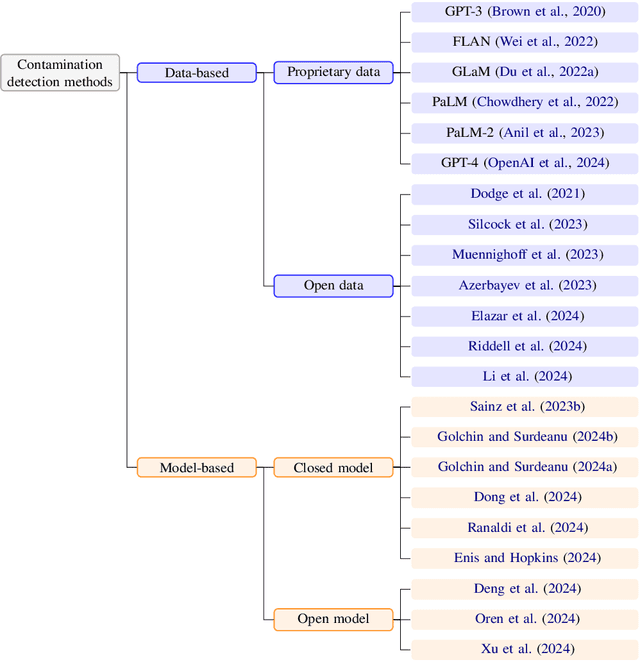
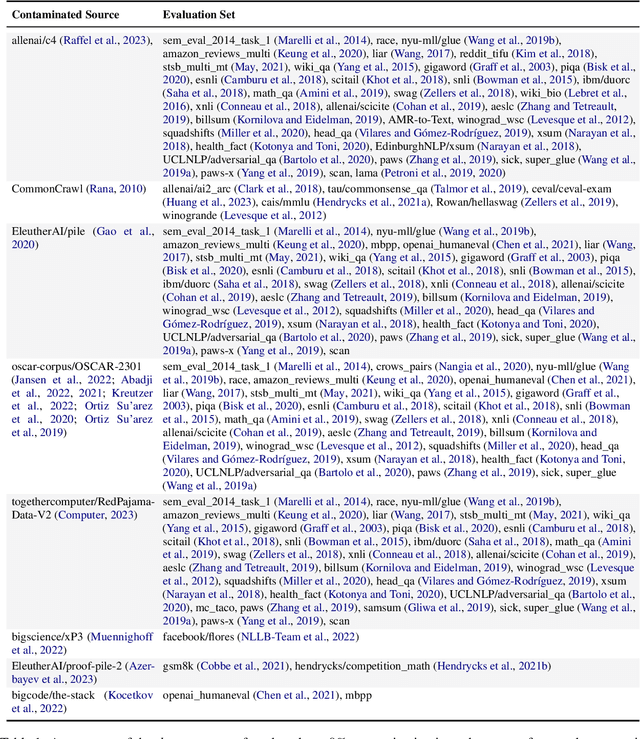
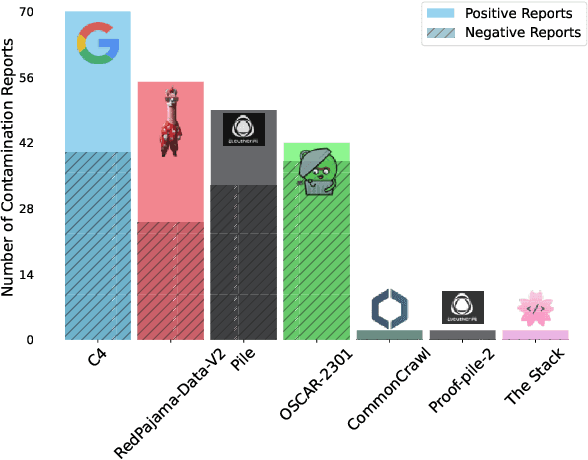
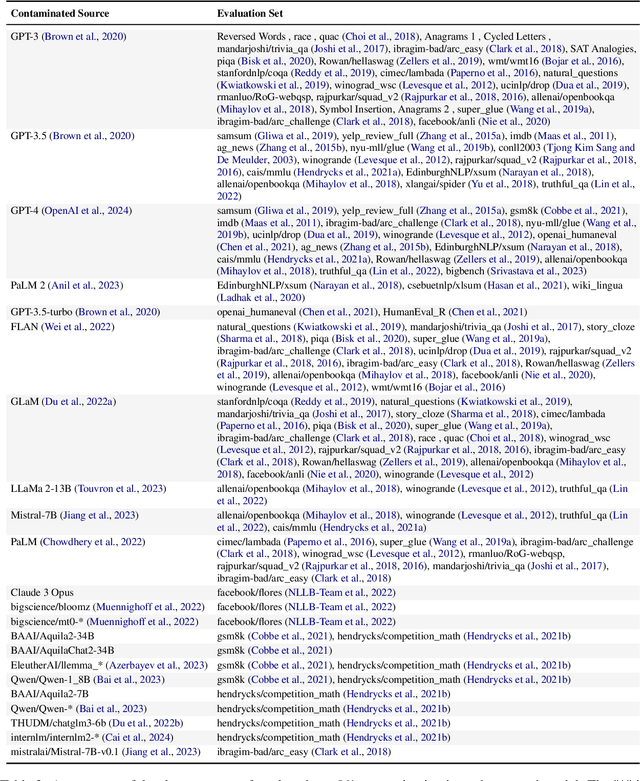
Abstract:The 1st Workshop on Data Contamination (CONDA 2024) focuses on all relevant aspects of data contamination in natural language processing, where data contamination is understood as situations where evaluation data is included in pre-training corpora used to train large scale models, compromising evaluation results. The workshop fostered a shared task to collect evidence on data contamination in current available datasets and models. The goal of the shared task and associated database is to assist the community in understanding the extent of the problem and to assist researchers in avoiding reporting evaluation results on known contaminated resources. The shared task provides a structured, centralized public database for the collection of contamination evidence, open to contributions from the community via GitHub pool requests. This first compilation paper is based on 566 reported entries over 91 contaminated sources from a total of 23 contributors. The details of the individual contamination events are available in the platform. The platform continues to be online, open to contributions from the community.
Fluorescence Diffraction Tomography using Explicit Neural Fields
Jul 23, 2024



Abstract:Solving the 3D refractive index (RI) from fluorescence images provides both fluorescence and phase information about biological samples. However, accurately retrieving the phase of partially coherent light to reconstruct the unknown RI of label-free phase objects over a large volume, at high resolution, and in reflection mode remains challenging. To tackle this challenge, we developed fluorescence diffraction tomography (FDT) with explicit neural fields that can reconstruct 3D RI from defocused fluorescence speckle images. The successful reconstruction of 3D RI using FDT relies on four key components: coarse-to-fine modeling, self-calibration, a differential multi-slice rendering model, and partial coherent masks. Specifically, the explicit representation efficiently integrates with the coarse-to-fine modeling to achieve high-speed, high-resolution reconstruction. Moreover, we advance the multi-slice equation to differential multi-slice rendering model, which enables the self-calibration method for the extrinsic and intrinsic parameters of the system. The self-calibration facilitates high accuracy forward image prediction and RI reconstruction. Partial coherent masks are digital masks to resolve the discrepancies between the coherent light model and the partial coherent light data accurately and efficiently. FDT successfully reconstructed the RI of 3D cultured label-free 3D MuSCs tube in a 530 $\times$ 530 $\times$ 300 $\mu m^3$ volume at 1024$\times$1024 pixels across 24 $z$-layers from fluorescence images, demonstrating high fidelity 3D RI reconstruction of bulky and heterogeneous biological samples in vitro.
MInference 1.0: Accelerating Pre-filling for Long-Context LLMs via Dynamic Sparse Attention
Jul 02, 2024


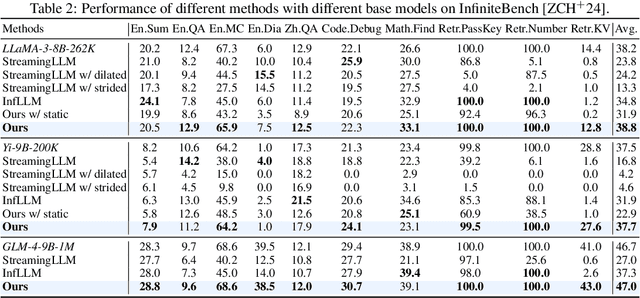
Abstract:The computational challenges of Large Language Model (LLM) inference remain a significant barrier to their widespread deployment, especially as prompt lengths continue to increase. Due to the quadratic complexity of the attention computation, it takes 30 minutes for an 8B LLM to process a prompt of 1M tokens (i.e., the pre-filling stage) on a single A100 GPU. Existing methods for speeding up prefilling often fail to maintain acceptable accuracy or efficiency when applied to long-context LLMs. To address this gap, we introduce MInference (Milliontokens Inference), a sparse calculation method designed to accelerate pre-filling of long-sequence processing. Specifically, we identify three unique patterns in long-context attention matrices-the A-shape, Vertical-Slash, and Block-Sparsethat can be leveraged for efficient sparse computation on GPUs. We determine the optimal pattern for each attention head offline and dynamically build sparse indices based on the assigned pattern during inference. With the pattern and sparse indices, we perform efficient sparse attention calculations via our optimized GPU kernels to significantly reduce the latency in the pre-filling stage of long-context LLMs. Our proposed technique can be directly applied to existing LLMs without any modifications to the pre-training setup or additional fine-tuning. By evaluating on a wide range of downstream tasks, including InfiniteBench, RULER, PG-19, and Needle In A Haystack, and models including LLaMA-3-1M, GLM4-1M, Yi-200K, Phi-3-128K, and Qwen2-128K, we demonstrate that MInference effectively reduces inference latency by up to 10x for pre-filling on an A100, while maintaining accuracy. Our code is available at https://aka.ms/MInference.
 Add to Chrome
Add to Chrome Add to Firefox
Add to Firefox Add to Edge
Add to Edge